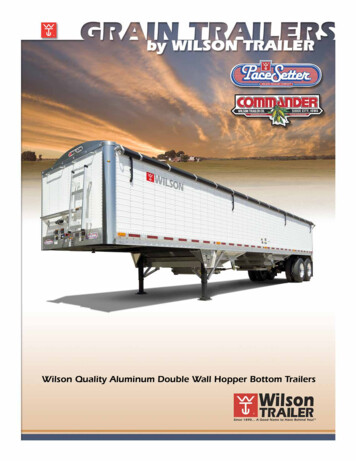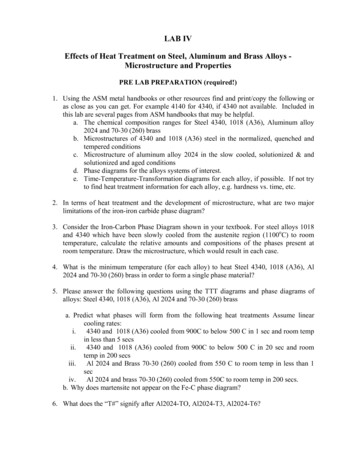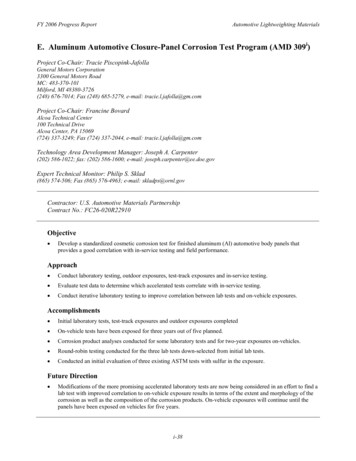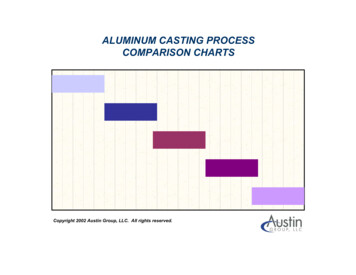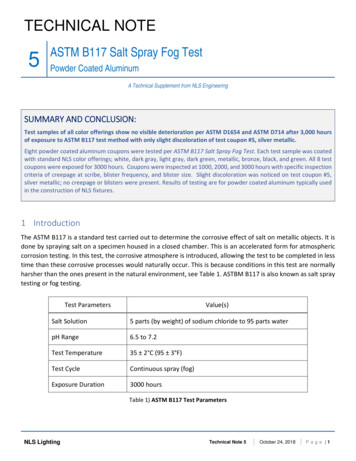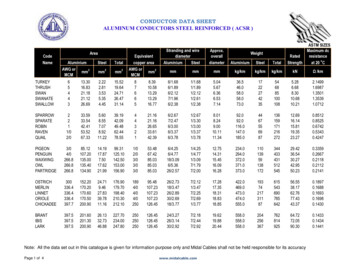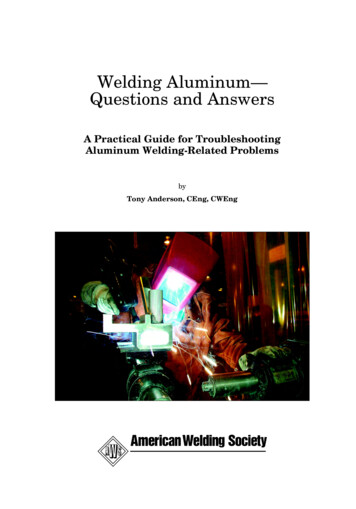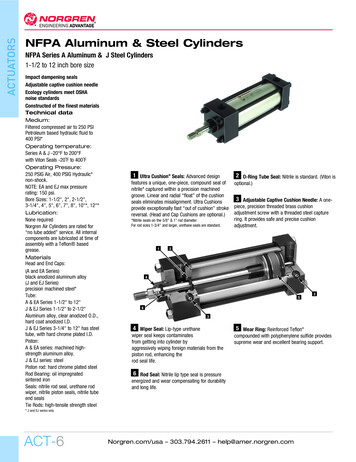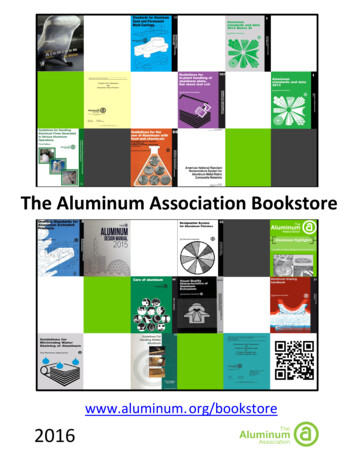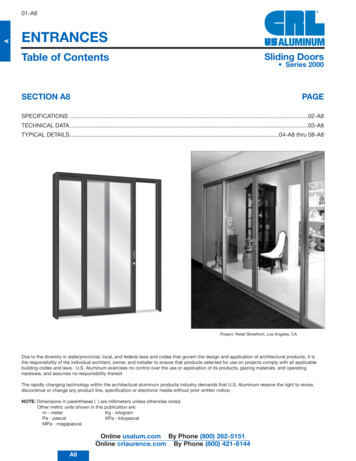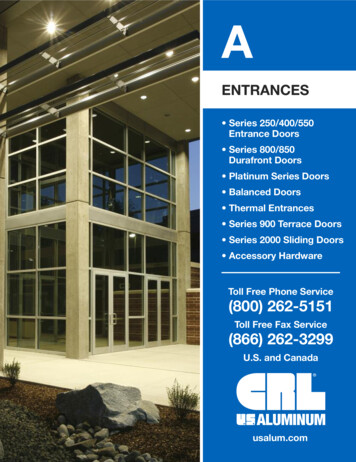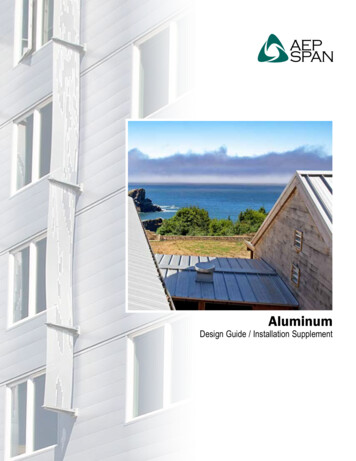
Transcription
AluminumDesign Guide / Installation Supplement
This aluminum panel design guide / installation guidesupplement provides general information and guidancefor AEP Span products manufactured out of aluminum.Refer to the standard AEP Span product installationguides for installation recommendations and refer to thissupplement for additional considerations and informationspecific to aluminum.ALUMINUM MATERIAL SUMMARYPhysical properties of AEP Span’s aluminum offering:Alloy:Yield (typ.):Tensile (typ.):Coefficient ofThermalExpansion:Weight:3003-H14(3105-H26 alt.)17ksi20ksi0.0000133” growth of 1” ofmaterial per each degree oftemperature rise0.098lbs/in3KEY ATTRIBUTES IN DETAILCorrosion Resistance:Bare aluminum quickly develops a durable oxide film onthe surface when exposed to air. This transparent, verythin oxide layer is nearly impervious to furthercorrosion. This drives the desire for utilizing aluminumin coastal (corrosive) environments as well asapplications that produce many cut edges. Perforatedpanels are also very popular in aluminum due to thecorrosion resistance around the punched holes. No redrust around perforation edges like what often occurswith steel panels.- Properties obtained from The Aluminum Association’sAluminum Design Manual.- AEP Span aluminum alloys and product design in complianceto ASTM B209, Standard Specification for Aluminum andAluminum-Alloy Sheet and PlateProducts manufactured out of aluminum have specificcharacteristics that provide both benefits and limitationsfor their use as single skin metal roof and wall panels.Benefits: Highly corrosion resistant. Develops durable oxidelayer.Lightweight. Weighs about 1/3 that of steel panels.Limitations: Lower strength vs. steel.High thermal expansion. Panels will expand/contractin length twice the rate of steel.More expensive.Thermal Expansion / Contraction:The thermal expansion/contraction of aluminum isdouble the rate of steel. A common rule of thumb forsteel is to expect roughly 1/8” expansion for every 10ftof panel length. For aluminum, this equates to 1/4" per10ft of panel length. Panel buckling/oil-canning, panelslotting around fastener shanks, and other installationconcerns must be carefully evaluated.
Strength:Roll forming aluminum alloys utilized for single skin metalroof and wall panels generally have a low yield strength.For reference, AEP Span offers 22ga ( 0.030”) steelpanels with a 50 ksi yield strength. Similar thickness.032” aluminum panels offered by AEP Span have a yieldstrength of 17 ksi – only 35% that of steel. Panel damagemay occur if panels are not handled carefully or properlyselected for final application. Since roll forming grades ofaluminum alloys are lower strength and do not springback like steel under focused loads, they have a higherrisk for permanent deformation.CORROSIONAs with all metals, aluminum can also be impacted by theeffects of corrosion. Aluminum itself is highly corrosionresistant, but contact with dissimilar metals may create acorrosion risk.The risk and extent of corrosion is based on manyfactors, including (but not limited to): Difference in galvanic potential between the twomaterials. Properties of the electrolyte (moisture),including:o Temperatureo PHo Flow/movemento Conductivity Barriers that exist – films, paints, oxides. Area difference between the dissimilar metals. Amount of material contact or separation. Amount of oxygen present. Temperature. Physical or environmental cycling.Fastener compatibility:The table below provides basic guidance regardingfastener materials recommended for the attachment ofaluminum panels. Please note that the table does notevaluate the fastener’s corrosion compatibility withvarious underlying substrates, just compatibility with thealuminum panel. Compatibility listed in table also appliesfor small accessories (panel clips, clamps, etc.) in directcontact with the aluminum panels.The following chart shows the relative galvanic potentialof various materials.E: Excellent VG: Very good G: Good P: Poor1. 300 Series: Excellent fastener for all-around usage.Developed chromium oxide layer is non-reactive.
2. Zinc with Inert Coating: The common premiumconstruction sheet metal fasteners. May be acceptable innon-corrosive environments. AEP Span recommendsutilizing a 300 series stainless fastener instead.3. Zinc Plated: Not recommended.4. 400 Series: Relatively poor corrosion resistancecompared to 300 Series SST. Not recommended.5. Heavy Zinc Capped: Reasonable for some exposedfastener applications.6. Hot Dipped Galv.: Good resistance. Fastener usage notcommon for metal roof & wall installations.7. Aluminum: Excellent match. Commonly bolted orriveted connections. Self-drilling fasteners are not available.Concealed fasteners and clips:Clips and fasteners shielded from moisture and outsideof coastal (1000ft or farther from salt-water/marineenvironments) or industrial exposure are generallyacceptable with standard G90 galvanized clips and highquality zinc-plated fasteners with organic (inert) coatings.The risk of galvanic corrosion is low when dissimilarmaterials are not in the presence of moisture.Applications where the panel clips and clip fasteners areexposed to the elements – high condensation, coastalfog, industrial exposure, etc. generally require the use ofstainless steel clips and clip fasteners to avoid acceleratedcorrosion rates.IBC language:Per 2018 IBC, Section 1507.4.4:3. Stainless steel fasteners are acceptable for alltypes of metal roofs.4. Aluminum fasteners are acceptable for aluminumroofs attached to aluminum supports.Other fastener materials may be acceptable however arenot explicitly mentioned within IBC.Corrosion concerns are not just limited to theinteraction of the panels, clips, and fasteners; other roof& wall connections and nearby components are also atrisk for contributing to galvanic corrosion. These includeitems such as gutters, valleys, and curbs where dissimilarmaterials may be used to direct water runoff fromaluminum panels.Panel Types & Corrosion:Concealed Fastened Applications (Standing Seam, etc.)Concealed fastened panels are those with no attachmentfasteners exposed to the environment.For these applications, standard, high quality zinc-platedfasteners with organic (inert) coatings are generallyacceptable for use within panel assemblies. Forapplications where the underside of panels are exposedto persistent moisture, in coastal climates, orpolluted/industrial environments it is recommended that300 series stainless steel clips and fasteners be utilized.Exposed Fastened Applications (Corrugated roofing/siding)For most exposed fastener applications with aluminumpanels, the usage of stainless steel fasteners is stronglyencouraged to reduce risk of galvanic corrosion.NOTE: The corrosion information presented above isfor general guidance only. Designing for corrosionresistance can be complex and some applications mayrequire a specialist to perform a detailed corrosionanalysis.ADDITIONAL CONSIDERATIONSAluminum Hail ResistanceAluminum roofing products have much less resistance tohail damage and are not recommended for areas with anotable risk of hail. The low yield strength of aluminumprovides little resiliency to hail impact.Fire ResistanceThe requirements and approvals for AEP Span steel roofand wall panels also applies to products produced out ofaluminum. Fire resistant assemblies exist for applications
governed by IBC, IRC, UL, IWUIC, among others.Contact AEP Span for any clarification.FASTENERSThe following is a list of available stainless steel fastenersfor use with AEP Span aluminum panel installationsInstallation SubstratesIdeally, aluminum panels are best installed over rigid, orsemi-rigid substrates and not over open framing toreduce the risk of product damage. Areas with foottraffic should be installed over solid or closely spacedsheathing to reduce risk of cosmetic damage to product;Installations over spaced framing concentrates loads overframing locations which may buckle ribs, or otherwisetelegraph substrate read-through to the panel surface.For exposed fastened aluminum roof panels oversensitive spaces, the usage of ice & water shieldunderlayment is recommended to act as a secondarybarrier for water infiltration through compromisedfastener attachment holes.Panel thicknessAEP Span offers several products in both .032 and .040aluminum. AEP recommends the usage of .040”aluminum to increase durability of finished product.Products subject to foot traffic, or higher loads shouldutilize .040” aluminum. Heavily corrugated (rigid)products like Nu-Wave Corrugated and HR-36 aregenerally acceptable in .032” in numerous applications,especially if located in project areas not subject toexcessive loads.Concealed-fastener panel installations (standing seampanels, etc.):Stainless Steel Fasteners: Concealed Fastener Panels300 Series StainlessPanel LapsLap FastenerSize: #12Head: HWHDrive: 5/16" Hex1": SFS #1123164Alternate Lap Fast.Size: 1/4"Head: HWHDrive: 5/16" Hex1-1/8": SFS #1133512Size: #14Head: HWHDrive: 5/16" Hex1-1/8": SFS #1141971Size: #12Head: HWHDrive: 5/16" Hex1-1/4": SFS #1134304Size: #12Head: HWHDrive: 5/16" Hex1-9/16": SFS #770786Size: #10Head: TrussDrive: Torx T201": SFS #1193547Size: #14Head: TrussDrive: #3 PH2": SFS #7913733": SFS #7913764": SFS #7913795": SFS #791381etc., (12" max.)Size: #10Head: PancakeDrive: #2 SQ1": SFS #15458912": SFS #1545895Steel SubstratesIntoLight Structural.035"-.098"IntoMed. Structural.060"-.157"IntoHeavy Structural.157"-.550"Pan HeadLong LengthLow Head400 Seri es SSTWood SubstratesIntoLumber/ Ply. / OSB
Exposed-fastener panel installations (corrugated,through-fastened panels.):Stainless Steel Fasteners: Exposed Fastener Panels300 Series StainlessPanel LapsLap FastenerSize: #12Head: HWHDrive: 5/16" Hex1": SFS #1123164Alternate Lap Fast.Size: 1/4"Head: HWHDrive: 5/16" Hex1-1/8": SFS #1133512Size: #14Head: HWHDrive: 5/16" Hex1-1/8": SFS #1141978Size: #12Head: HWHDrive: 5/16" Hex1-1/4": SFS #1122767Size: #12Head: HWHDrive: 5/16" Hex1-9/16": SFS #770785IntoLumber/ Ply. / OSBSize: #9Head: HWHDrive: 1/4" Hex1": SFS #7907551-1/2": SFS #7909052": SFS #1411486Alternate Wood Fast.Size: #14Head: HWHDrive: 3/8" Hex1": #7903961-1/2": #7904432": #790470etc., (8" max.)Steel SubstratesIntoLight Structural.035"-.098"IntoMed. Structural.060"-.157"IntoHeavy Structural.157"-.550"This aluminum panel design guide / installation guidesupplement provides general information andconsiderations regarding AEP Span’s aluminum productoffering. Please refer to the AEP Span website forproducts currently available in aluminum and applicableproduct options and limitations. Also refer to thestandard AEP Span product installation guides forinstallation recommendations and refer to thissupplement for additional considerations and informationspecific to aluminum.SUPPLEMENTAL ALUMINUM INSTALLATIONDETAILSWood SubstratesRequires pre-drilledpi l ot holesSUMMARYThe following pages contain supplemental installationdetails that focus on a few key aluminum installationareas, most notably around the topic of thermalexpansion. Refer to AEP Span’s standard installationguides for all other available details.
MANUFACTURING FACILITY:Tacoma, Washington2141 Milwaukee WayTacoma, WA 98421Fontana, California10905 Beech AvenueFontana, CA 92337CORPORATE HEADQUARTERS:ASC Profiles LLC2110 Enterprise BoulevardWest Sacramento, CA 95691CUSTOMER SERVICE:800-733-4955Visit us at:www.aepspan.com 2019 ASC Profiles LLC. All rights reserved.
05.08.2019 · Aluminum Design Manual. - AEP Span aluminum alloys and product design in compliance to ASTM B209, Standard Specification for Aluminum and Aluminum-Alloy Sheet and Plate. Products manufactured out of aluminum have specific characteristics that provide both benefits and limitations for their use as single skin metal roof and wall panels. Benefits: Highly corrosion resistant. Develops

